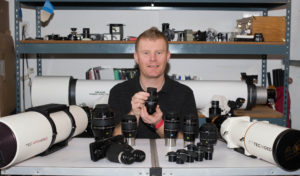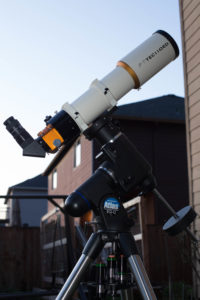What's the best beginner / first "real" telescope eyepiece? Baader Planetarium 8-24mm Hyperion Zoom!
By: Vlad Fedosov
Intro:
So you bought yourself a nice scope and are now thinking of expanding from the bundled eyepieces that your scope came with? This is an exciting time and I vividly remember the first time I laid out $300 for my first real eyepiece back in the late 1990’s; a 14mm Meade UWA. Fast forward 20+ years and I have owned more scopes and accessories then I can count(terrible issue right? LOL. below is an image of my current eyepiece kit). So what eyepiece do I find myself using the most? Well you would probably be surprised to learn that it is far from my most expensive or fanciest piece of glass. The eyepiece that I use the most, and think anyone should concider as their first quality eyepiece investment is the Baader 24-8mm Zoom! As the name implies it has a 24mm to 8mm zoom range with an apparent field of view(FOV) of 50-68 ° and an eye relief of 15mm to 12mm. The eyepiece weights in at 10.2oz. So, with all the tech specs out of the way lets dive into why I think that this is the top eyepiece choice for you!

Testing:
My story with this eyepiece started at a star party that I attended about 3 years ago hosted by my astro club; the Rose City Astronomers. I was casually scope hopping to get some views through some cool setups. Approaching one of the club members scopes he offered that I take a look. I’m not one to refuse having a look, so I began looking through what appeared as a relatively large eyepiece an an open star cluster. Of course it was dark out so I had no idea what the setup I was lookign through was. The FOV looked fairly wide, and the image was nice and crisp. If I had to guess I would have though this was a TeleVue Panoptic or one of Explore Scientifics 68 ° FOV eyepieces that I was looking thorough. At this point the owner proudly proceeded to tell me that this was a new eyepiece that he had recently picked up; the Baader 24-8mm Zoom… When I heard that I was actually looking through a zoom eyepiece my socks where nearly blown off. I had tried zoom eyepieces in the past, and every time I was disappointed because of the soft dim image they produced. I could not believe that this thing had such a crisp bright image. With the owner’s permission I ran it through the zoom range to give it a bit of a trial run and the first impressions did not disappoint. Let’s just say that the next morning one of these was on its way to be delivered to me. Yes, I was that impressed!

Once I received the eyepiece I started using it with some of my own scopes. The more I used it the more I liked it. The shorter zoom range gets you to a wider FOV. When you are at the 8mm setting you enjoy a generous FOV of 68°. I find this ample even for deep sky object observing. Closer to the wider 24mm setting the FOV unfortunately does contract down to a relatively narrow 50°. Its not too bad but I do prefer a bit wider experience for deep sky object(DSO) work. Speaking of the zoom range the operation of the zoom mechanism is usually quite smooth and does have nice click stops at the 24, 20, 16, 12, and 8mm settings. This is quite handy if you plan on using two of these in a binoviewer in the future. Now notice that I said that the mechanism is usually smooth. When I first bought the eyepiece is was very smooth in the summer but as I started using it in the winter months it became quite stiff and the click stops where not very defined. It was certainly affected by the cold. Once it was warmer again it became smooth. Interestingly enough this winter I have not experienced it getting stiff??? But I’ll take it! I also would like to note that I own the Mark III version of the eyepiece and from what I understand the new Mark IV version of the eyepiece addresses some of the zoom stiffness.
So how sharp and contrasty it the eyepiece? Well as you can see in the picture above I have a fairly decent eyepiece collection(and have owned and tried many, many other eyepieces) and on at least 90% of nights of seeing I know for a fact that this eyepiece is sharp enough to show me all the detail that is there to see. In fact, I have compared the zoom to my Baader Classic Orthos(very good planetary eyepieces) on many occasions and I every time I was really, really hard pressed to tell the difference in sharpness/contrast/light scatter. The only exception is the 8mm setting. For some reason for crucial planetary observing I find that its not quite as sharp as the other parts of the zoom range. Not a huge diffrance but it is there.
The overall eye relief on the eyepiece is very comfortable. I don’t wear glasses so do keep this in mind. The eyepiece does come with a nice eye guard but I never use them on any of my eyepieces(personal preference). The eyepiece also does include a nice carry pouch for transporting it. Now normally this would be kind of a gimmicky storage solution for an eyepiece but in the case of the zoom it works really well when you want to bring just one eyepiece with you. There are many times that I’m traveling light to a star party of just for a quick look in the backyard and this is the only eyepiece that I bring with me! The pouch certainly is handy in those situations.
Let’s tie this all together and get to the bottom of why this is my most used eyepiece and why I think this should be your first serious eyepiece purchase. I personally use the eyepiece a lot with my refractors. Paired with the Badder 2.25x Barlow I can get a very wide magnification range form my grab and go refractors(about 30x-200x with my 110mm APO). This is very, very handy and can cover me for most observing ranging from deep sky to planetary. As I mentioned above, I never feel like I’m really giving up any performance to my other eyepieces sharpness and contrast wise on all but the steadiest nights. The other thing that I really enjoy is that I can fine tune to the exact magnification that I need for an object of the exact way I want to frame it.
Now if your new to the hobby and bought something like the Nexstar SE6(witch is my pick for the best serius bigginer scope) scope you will get a magnification range of ~66-200x covering you for the most useful magnifications that you will be using. You have one eyepiece that gives you a relatively wide FOV eyepiece in the 12-8mm range that is on par with other premium offerings. In addition you get a decent wider FOV experience closer to 24mm. I often do use a 40mm Explore Scientific 68° FOV eyepiece for DSO work in addition to the zoom. This is the ultimate combo and if I had to pick only two of my eyepieces to take with me to a star party these would be my top choices(depending on the scope I might switch out the 40mm with my 25mm 100° FOV). As mentioned above if you do have a short focal length refractor I would buy the kit that includes the 2.25x Barlow lens. I find this Barlow an excellent value for the money and right up there performance wise with some of the best Barlows that I have tried.
Conclusion:
In conclusion I just want to say that this really is an awesome piece of glass. I hope that you got a sense for how versatile the eyepiece is. Yes, its not a very cheap starter eyepiece to recommend but I firmly believe that its money very well spent. It is an eyepiece that you will use a lot when you are new to the hobby, and one that you will continue to use even when you do upgrade to those monster 100° FOV eyepieces. Its just so convenient to have one eyepiece that you can grab and cover most of your observing needs!
Support AVT-ASTRO
If you found this review helpful and are considering purchasing the product that was discusses please concider purchasing this item on Amazon using the link here. I get a small commission from Amazon and it really helps to pay for running this site!
